Furunculosis in dogs is a painful skin condition that involves inflammation and infection of the deep layers of the skin surrounding the hair follicles. Affected dogs often have bumps or boils on their skin that may be pus-filled, draining, or ulcerated. Integrative veterinarian Dr. Julie Buzby explains the causes, symptoms, diagnosis, treatment, and prognosis for three common types of furunculosis: interdigital furunculosis, anal furunculosis, and post-grooming furunculosis.
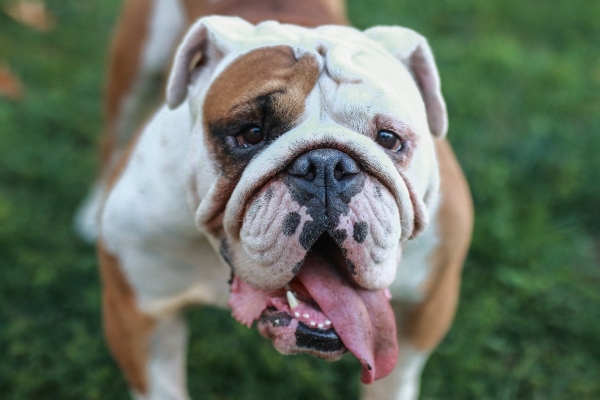
Most dog parents are familiar with the occasional hot spot, bacterial or fungal skin infection, or other skin issues. The good news is that the majority of these lesions (i.e. abnormal areas) are very superficial in nature. Plus, they typically resolve quickly and easily.
However, some skin lesions can end up being deep bacterial infections that take several weeks to fully clear up. With that sort of dog skin infection, furunculosis might be the culprit.
What is furunculosis in dogs?
Furunculosis is a deep infection (usually bacterial) or inflammation of the skin that leads to painful boils, draining tracts, swelling, and ulceration of the skin. This skin condition occurs in the portion of the skin below the surface and affects the area around the hair follicles as well as the follicles themselves.
As the name may imply, hair follicles are very small pores located within the skin that hair grows out of. When the follicles become infected or inflamed, the contents tend to move outward. The end result is a furuncle, which is a boil or abscess-like lesion that originates from the hair follicle. The term “furunculosis” describes a condition where the dog has furuncles.
What are the types of furunculosis in dogs?
In order to discuss the intricacies of this dog skin infection, it is easiest to classify furunculosis into types based on the location where it occurs. Three common places for furunculosis in dogs are:
- Paws (i.e. interdigital furunculosis)
- Anus (i.e. anal furunculosis or perianal fistulas)
- Along a dog’s back (i.e. post-grooming furunculosis)
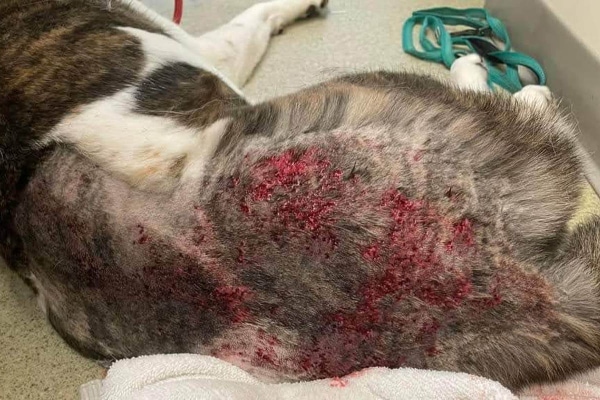
That’s not to say that you won’t occasionally see furunculosis on a dog’s chin, nose, chest, or other places.
Muzzle folliculitis and furunculosis in dogs (chin acne)
For example, some dogs might have muzzle folliculitis and furunculosis (i.e. chin acne). This is most common in short-coated young dogs and occurs when dogs rub their chin on an object, breaking the hairs and driving them into the skin.
The resulting inflammation around the hair follicle shows up as multiple small red bumps on the chin and lips. It sort of looks like the dog has acne, hence the name. Your veterinarian will typically take samples to look for bacterial, yeast, or fungal infections. Depending on the results, the vet will treat the muzzle folliculitis and furunculosis using oral or topical antimicrobials and/or anti-inflammatories.
Eosinophilic furunculosis in dogs
Or a dog might have eosinophilic furunculosis in dogs, which tends to occur in response to an allergic reaction to an insect bite. Those dogs often have ulcerated areas of the skin or bumps that appear quickly around the face and muzzle. Eosinophilic furunculosis treatment for dogs typically involves steroids and possibly antibiotics if there is secondary infection.
However, those types of furunculosis are less common, so our discussion will focus on furunculosis of the paws, anus, and back.
1. Interdigital furunculosis in dogs
Interdigital furunculosis is also known as pododermatitis, podofurunculosis, pedal furunculosis, or interdigital cysts in dogs. As the name might imply, it usually affects the interdigital region, which is the area between the toes.
Most dogs tend to have hair of some length between their toes. When the interdigital hair follicles become irritated or traumatized, the resulting inflammation causes the follicles to dilate. Then the skin itself begins to appear swollen or cyst-like. Even if the inflammation starts out underneath the paw, it tends to migrate to the paw’s upper surface.
Causes and predisposing factors
There are a variety of reasons that certain dogs may be more likely to develop interdigital furunculosis:
Hair length
Dogs with shorter hair coats such Basset Hounds, English Bulldogs, Bull Terriers, Boxers, Great Danes, Mastiffs, and Staffordshire Terriers as are more likely to develop interdigital furunculosis. This makes sense because longer haircoats may be more protective against elements that could irritate the paws. Plus, short bristly hairs tend to be more irritating to the space between the toes.
Paw conformation
Dogs with wider paws and a larger distance in between the pads on the paws are more likely to experience interdigital furunculosis. This is because the delicate furred skin between the toes is more likely to contact the ground or rough surfaces when the pup goes to take a step. Large breed dogs like Labrador Retrievers and German Shepherd Dogs can experience this, as can certain small breed dogs like the Pekingese.
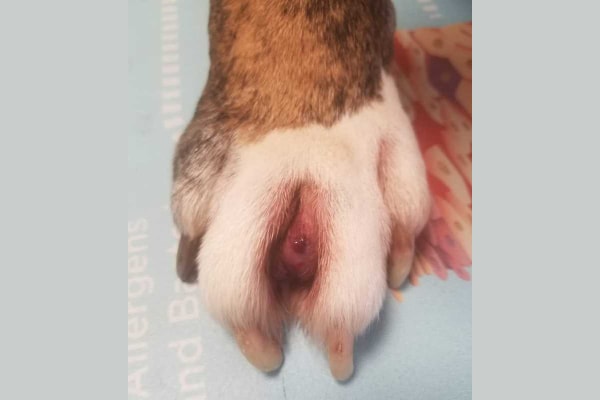
Additional factors
Several other factors can also influence the development of interdigital furunculosis in dogs:
- Body weight—interdigital furunculosis is more common in overweight and obese dogs or those who are bearing weight abnormally on a paw
- Excessive paw licking—a dog’s itchy paws may be due to atopic dermatitis (i.e. environmental allergies), food allergies, anxiety, or other factors
- Foreign bodies such as sharp objects or plant material (e.g. foxtails in dogs)
- Parasites such as demodex (the cause of demodectic mange) and hookworms
- Endocrine diseases like hypothyroidism in dogs and Cushing’s disease in dogs
- Fungal or bacterial infections (commonly isolated bacteria include Staphylococcus pseudintermedius and Staphylococcus epidermidis)
Symptoms of interdigital furunculosis in dogs
A combination of these factors can lead to inflammation of the interdigital region and eventually furunculosis. Initially the dog may start out with mild redness (i.e. erythema) in between the toes. The inflammation may gradually intensify and causes the skin to become swollen (i.e. edematous). Pustules and focal nodules that look like little bumps can also appear.
If there is foreign material in the paw, you may notice a bleeding or draining tract where the object pierced the skin. Bacterial furunculosis in dogs can also be a “smelly” condition. Some owners may notice a foul odor around their dog’s paws.
Your pup may also experience itchiness or pain and will try to lick his or her paws frequently. Over time, the chronic irritation from licking and the inflammatory process can lead to thickening of the skin (i.e. lichenification). These changes can make it more difficult to treat secondary bacterial or fungal infections.
If you notice any of these symptoms, it is best to schedule an appointment with your vet. The sooner you can get to the bottom of the issue, the sooner your dog can get some relief.
Diagnosis of interdigital furunculosis in dogs
The vet will carefully examine your dog from head to toe, with a special focus on your dog’s paws. Most of the time, the vet ends up basing the diagnosis of interdigital furunculosis on your dog’s medical history and clinical signs. The vet may also use special skin diagnostics such as skin scrape testing and skin cytology. These tests are a great way to look for bacteria, yeast, inflammatory cells, or parasites like demodex.
If your vet suspects your dog has an underlying endocrine disorder, he or she may want to perform a few specific urine tests or blood tests for dogs. Also, sometimes a dog doesn’t respond to the first line treatments. In those cases, the vet may recommend bacterial cultures and skin punch biopsies to get more information about what is going on. Or he or she may refer your dog to a veterinary specialist near you, namely a veterinary dermatologist.
Interdigital furunculosis in dogs treatment
When treating furunculosis of a dog’s paw, one of the most important steps is to work with your veterinarian to address the underlying cause. For example, managing a dog’s allergies or anxiety may help reduce future episodes of interdigital furunculosis. Or controlling an endocrine disease can restore your dog’s skin health.
When it comes to addressing the inflammation and infection that accompany interdigital furunculosis, treatment involves:
Systemic antibiotics
Since the infection is so deep in the dog’s skin and hair follicles, the vet will typically prescribe a long course of systemic (oral) antibiotics—potentially for up to 12 weeks.
Topical treatment
Additionally, dogs may benefit from medicated shampoos, ointments, sprays, and leave-on mousse products. In some cases, soaking the feet also makes a great home treatment for interdigital furunculosis in dogs.
Skin support products
Dogs with interdigital furunculosis can benefit from topical products containing ceramides for dogs and phytosphingosine, which can help replenish a diseased skin barrier. Plus, omega-3 fatty acids for dogs are another great way to support skin health, and they have natural anti-inflammatory properties too.
Anti-inflammatories or anti-itch medications
In more severe cases of furunculosis, the vet may prescribe prednisone for dogs or other steroids to alleviate intense inflammation and pain. Alternatively, for more mild cases that are likely due to allergies, the vet may recommend newer allergy medicines for dogs such as Apoquel and Cytopoint, which tend to have fewer side effects than steroid medications.
Paw protection
PawZ dog boots can be a good way to protect the paws from further exposure to the elements when going outside. It is important you remove them promptly when coming inside, though. Also, before using PawZ dog boots, ask your vet if they are right for your dog. Sometimes putting them on inflamed feet may be more painful than helpful for your dog.
Surgery
In severely affected dogs, a small animal vet or board-certified veterinary surgeon may remove the cyst and inflamed tissue between the toes.
Prognosis
With appropriate treatment, the prognosis for dogs with interdigital furunculosis is good. Also, it is unlikely for furunculosis in dogs to be contagious, so you don’t have to worry about your dog passing it to his or her friends.
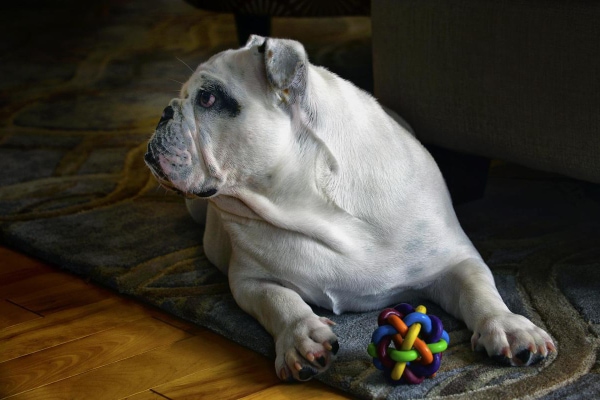
While the outlook is positive, I do have to warn you that it is still important to follow your vet’s treatment directions. I know that especially if you have a dog who won’t take pills, it can be tempting to stop giving the antibiotics once it seems like your dog is back to normal. However, it is important to treat most dogs for a week or two beyond the resolution of clinical signs.
Infections that coincide with interdigital furunculosis can be very deep. If you stop the treatment before the infection is completely gone, it may come back. Also, stopping antibiotics too soon can promote bacterial resistance.
#2: Anal furunculosis in dogs
Furunculosis can also develop around a dog’s anus and perianal regions. This is sometimes also referred to as a perianal fistula or perianal furunculosis in dogs. Unlike interdigital furunculosis, anal furunculosis tends to be a chronic inflammatory disease that usually requires repeat therapies, if not lifelong treatment.
Causes and predisposing factors
The true cause of anal furunculosis in dogs is unknown. However, most veterinary experts feel that it is an immune-mediated disease. In other words, the dog’s immune system begins to attack the skin around the anus. There may also be a link between chronic colitis (i.e. inflammation of the colon) and perianal fistulas in German Shepherds.
Anal furunculosis primarily affects middle-aged dogs, and it may be hormonally influenced because it seems to occur more in intact male dogs. German Shepherd dogs appear to be the most commonly affected dog breed. Other affected breeds include the Australian Shepherd, Beagle, Bulldog, Labrador Retriever, Old English Sheepdog, and Staffordshire Terrier.
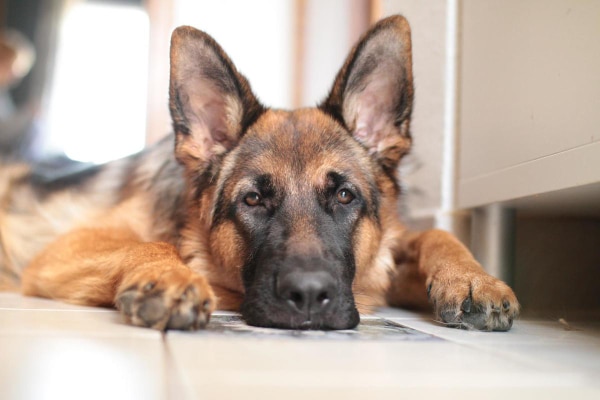
Symptoms of anal furunculosis in dogs
Unfortunately, the trouble with anal furunculosis is that initial signs can be difficult to detect. This is especially the case in dogs with longer fur in the perianal areas like German Shepherds. Some dog parents may not notice any clinical signs until they see their canine companion scooting his or her hind end across the floor or notice their dog licking the base of the tail repeatedly. Since it is a painful condition, some pups will carry their tails very low or tucked under their bodies.
When looking underneath your dog’s tail, you may observe a small hole or draining tract coming from your dog’s anus, or immediately next to it. Other clinical signs associated with anal furunculosis include the following:
- Straining to defecate (i.e. tenesmus)
- Painful defecation (i.e. dyschezia)
- Bleeding from the anus or bright red blood in the stool (i.e. hematochezia)
- Smelly or pus-like discharge from or around the anus
- Diarrhea or constipation
- Weight loss
- A lethargic dog
If you see these signs, please contact your veterinarian. Because perianal furunculosis can sometimes be confused with anal gland issues in dogs like a ruptured anal gland or an anal gland abscess, a full clinical examination with your veterinarian is important.
Diagnosis of anal furunculosis
The vet will start by closely examining your dog and finding out a bit more about your dog’s history. This, plus the appearance of the lesions, may give your vet a pretty good idea that the diagnosis is anal furunculosis. However, in order to rule out other potential causes of these symptoms, (e.g. anal gland abscess, food allergy, or a tumor), your vet may recommend:
- A thorough examination with sedation on board. This is helpful because anal furunculosis can be extremely painful, making it difficult (and unfair to the dog) to try to examine the area in an awake dog.
- Skin cytology and culture testing to look for evidence of a secondary infection.
- Biopsy testing to help cross cancer off the problem list.
- General urine and blood testing to rule out infection elsewhere in the body since treatment often involves the use of immunosuppressive medications.
Anal furunculosis treatment in dogs
After reaching a diagnosis of anal furunculosis, the vet will discuss the next steps. The good news is that despite having an unknown cause, many dogs with perianal fistulas respond well to immunosuppressive medications. In the initial phase of treatment, the veterinarian will prescribe a higher dose of the medication until clinical signs resolve. This can take about four months in some cases, but maybe sooner in milder cases.
After the initial treatment phase, the vet will switch your dog to a lower dose of medication for maintenance purposes. Since 33 to 50% of cases recur after finishing treatment, your veterinarian may recommend continuing the maintenance dose of therapy for the life of the dog.
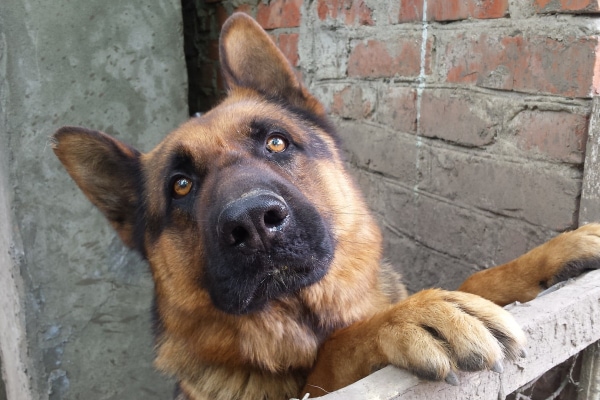
Oral immunosuppressive medications like cyclosporine tend to be the most effective treatment. In some cases, the vet may recommend using topical tacrolimus (another immunosuppressive medication) in conjunction with cyclosporine. And occasionally in mild anal furunculosis cases, topical tacrolimus can be a stand-alone treatment.
As a word of warning, these immunosuppressive medications can also suppress a human’s immune system. It is important to handle them with gloves and then wash your hands after treating your dog.
In addition to immunosuppressives, dogs with anal furunculosis may also benefit from:
- Pain medications to reduce pain and inflammation
- Fiber supplements for dogs to ease defecation
- Special diets to manage food allergies
- Surgical intervention as a last resort—it carries the risk of many complications, including anal strictures and fecal incontinence
Prognosis for dogs with anal furunculosis
Although there are good treatment options, ultimately, there is no cure for anal furunculosis in dogs. But the prognosis for these pups is still good when it comes to managing their clinical signs. Thankfully, most cases will start to show some inkling of improvement within the first couple of weeks.
Since many of these dogs require life-long (or at least long-term) medications, regular follow-ups with your vet are important. These appointments allow your vet to ensure the medications are working correctly and make any needed adjustments.
#3: Post-grooming furunculosis in dogs
Unlike interdigital furunculosis and anal furunculosis which had a variety of contributing factors or an unknown cause, post-grooming furunculosis has one distinct trigger—grooming. Post-grooming furunculosis is a skin disease of dogs which, like the name indicates, usually occurs in the first 24 to 48 hours after a grooming.
Causes and predisposing factors
During grooming, the skin or hair follicle may be traumatized or irritated by vigorous scrubbing and/or brushing the fur in a backwards direction. This is problematic because it causes small defects in the skin’s barrier. Normally, healthy skin does a great job of keeping bacteria from invading. But when the skin barrier breaks down, bacteria have free access to the hair follicles and deeper layers of the skin.
To further complicate matters, the disease-causing bacteria Pseudomonas aeruginosa can exist in wet environments. Bottles of soap and shampoo or damp grooming tools are the perfect places for it to thrive. Plus, Pseudomonas has special enzymes that help it attach to skin and evade the body’s defenses. This makes these infections difficult to treat.
The combination of a broken down skin barrier and exposure to contaminated grooming products or tools can lead to post-grooming furunculosis.
As you can imagine, this could potentially happen in any age, breed, or gender of dog. More studies indicate that short-coated breeds tend to be prone to developing post-grooming furunculosis. However, one study observed that it was most common in Labrador Retrievers and German Shepherd dogs, and another showed it was more common in dogs with medium or long haircoats. So the verdict is still out.
Symptoms of post-grooming furunculosis
As you can see from the picture below of post-grooming furunculosis, most affected dogs have skin lesions that are distributed across the tops of their upper and lower backs.
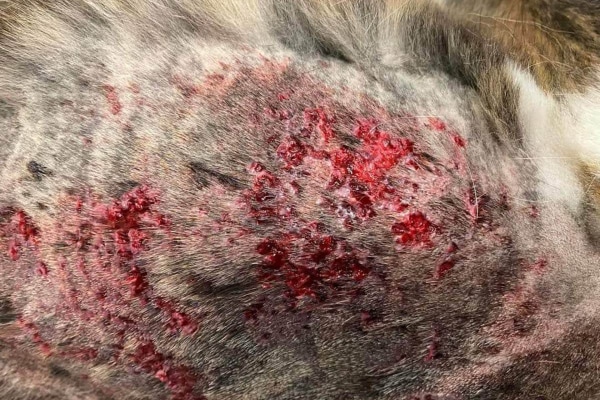
Sometime the lesions will spread down the sides of the body too. You may notice:
- Small red bumps called papules
- Large, ulcerated plaque-like lesions that are draining small amounts of fluid
- Bleeding areas of skin
- Signs your dog is in pain when you touch the affected areas
- Lethargy and/or fever in the first few days
If you notice these symptoms, please contact your veterinarian promptly. Dogs with post-grooming furunculosis or other deep skin infections affecting a large portion of their skin may be extremely painful. It is important to get them relief as soon as possible.
Diagnosis of post-grooming furunculosis
The history of being recently groomed plus the appearance of your dog’s skin will often help your vet reach a post-grooming furunculosis diagnosis. However, your vet may also recommend additional skin testing like cytology or culture. These tests can help rule out other underlying causes and guide antibiotic selection.
Especially if your dog has a fever or is lethargic, your vet may also decide to run blood tests such as a complete blood count (CBC). Dogs with post-grooming furunculosis may have normal bloodwork or may have elevated white blood cells in response to the infection.
Treatment of post-grooming furunculosis
Since this is a bacterial infection, antibiotics are the mainstay of treatment. Typically, the veterinarian will start your dog on an antibiotic that he or she thinks is likely to be effective against Pseudomonas or other bacteria that tend to cause post-grooming furunculosis. Fluoroquinolone antibiotics like marbofloxacin are often a good first choice while waiting for culture results.
Once the laboratory finishes the skin culture and sensitivity, the vet can use that information to modify the antibiotic selection if indicated. Most dogs need antibiotics for at least four to six weeks. Like with interdigital furunculosis, it is important that treatment extends two weeks past the resolution of clinical signs.
Unlike most other skin conditions, clipping the fur and topical therapies aren’t a good idea for post-grooming furunculosis. Clipping the fur can cause further trauma to the affected hair follicles. And since it is best to keep the skin clean and dry, adding more moisture in the form of topical therapy could make the infection worse. Plus, most dogs are too painful to tolerate anything being applied to their skin.
Since this condition is so painful, your vet may also recommend an anti-inflammatory medication for pain control. These medications can do a nice job with helping your dog be more comfortable.
Prognosis
Thankfully, with therapy, the prognosis for dogs with post-grooming furunculosis is good. Like other furunculosis conditions, it is crucial to attend recheck visits every two to four weeks to ensure that treatment is working. Also, keep in mind that it may take three to four weeks before you start seeing significant improvements in your pup’s condition.

Prevention
Out of the three types of furunculosis we discussed, post-grooming furunculosis is the one that is most preventable.
In order to avoid post-grooming furunculosis you should:
- Keep grooming products clean and dry
- Discard old bottles for soap and shampoo rather than refilling or reusing them
- Properly disinfect clipper blades and scissors
- Use gentle movements when bathing dogs, especially those with short hair coats
- Avoid brushing hairs in the opposite direction or aggressively brushing the coat with a sharp brush
- Bring any skin lesions to your vet’s attention as soon as possible
- Contact the grooming salon if your dog develops post-grooming furunculosis so they are aware of the issue and can take the appropriate steps to prevent it from happening to other dogs
Final thoughts on furunculosis
Furunculosis in dogs: Summary
Furunculosis in dogs is a painful inflammation and/or bacterial infection of the hair follicle and the deeper layers of the skin that surround the hair follicle. The three most common types are interdigital furunculosis, anal furunculosis, and post-grooming furunculosis:
Interdigital furunculosis—Swollen, red, painful, draining boils between the toes are the hallmark of interdigital furunculosis. Treatment involves a long course of antibiotics plus topical therapy and anti-inflammatory or anti-itch medications.
Anal furunculosis—This immune-mediated skin condition causes painful draining tracts around the anus. Treatment for anal furunculosis involves long-term immunosuppressant medications.
Post-grooming furunculosis—Signs of post-grooming furunculosis usually show up within 24-48 hours of being groomed and include bumpy, painful, oozing, and ulcerated skin over a portion of the body, most commonly the back. Treatment involves long courses of antibiotics plus anti-inflammatories.
As a dog parent, we want the best for our dear companions, and it is difficult to see them uncomfortable or in pain from furunculosis. The bad news is that furunculosis can be a bit tricky to treat, primarily because it can linger for weeks on end and requires long courses of medication.
However, by promptly taking your dog to the vet as soon as you notice skin issues and following your vet’s directions to the letter, you can get your dog on the path to recovery. There is light at the end of the tunnel. Although furunculosis looks bad, it typically does respond well to treatment. And soon enough your dog can be back to his or her old happy self!
What questions do you have about furunculosis in dogs?
Please comment below.


My pup Mia is about a year and a half, shepherd mix was groomed and de-shed on a Saturday morning at 9am. Sunday night and Monday she was lethargic, chugging water to cool herself down and panting. Took her to the emergency vet and she had a 105 fever. No sores yet but they said if they show up the next day it’s likely post grooming furnucliosis. The spots of course show up and her regular vet got her in the next day and prescribed antibiotics and a topical ointment. She’s doing much better now 5 days later but wondering when I can bathe her again? Due to the ointment in certain spots, she has a double coat so it’s kind of become tacky and her fur is stuck together near the infected spots. Definitely healing but I would like to give her a bath at some point. Would two week be good enough? I’m sure combing is out of the question. She is no longer in pain but a little itchy now suddenly. Likely the spots are drying out with the help of the antibiotics. Thank you!!
Hi Leah,
I am sorry your young pup experienced this painful condition. Two weeks should give the skin enough time to heal, but before bathing it would be ideal if all the spots were dry and not still oozing or weeping. When bathing you also have to be careful not to rub the hair backwards against the direction of normal growth. Hoping Mia has made a full recovery and wishing her all the best at avoiding another issue in the future.
My friends German Shepard is suffering with anal furuncolousis and is 20 days into a course of atopica and it has flared up again. He has 10 days left of his course. Is there any advice you can give. He suffers badly with vet visits and has to be sedated to be examined. Is there any ways of preventing flare ups, or ways to stop this reoccurring. And ideas of what can cause this so to prevent it coming back please? Does he need a different or stronger medication?
Hi Kelly,
I am sorry your friend is going through this worrisome and frustrating situation with their Shepherd. Unfortunately, this breed has a higher risk of this type of issue becoming a chronic problem than others due to a genetic predisposition. Their pup may need to try a different immunosuppressive medication even though the active ingredient in Atopica has been shown to be the most effective. It may be worth considering a consultation with a specialist. They have lots of experience dealing with complicated cases and might have ideas about treatments or therapies that are not readily available in general practice. You are a great friend to try and search for answers. Hoping for a clear path forward and praying for healing for your friend’s dog.
Thank you so much
Hi, I found a few scabs on my dog’s neck post grooming. The vet said it’s a hotspot and prescribed antibiotics but as soon as I stop the antibiotics I find new small scabs on other areas such as his back. This is going on for a few weeks and I suspect it could be Post-Grooming Furunculosis, not a hotspot or allergy. What would you recommend?
Hi Faye,
I am sorry your dog is dealing with these worrisome skin lesions. Unfortunately, without examining them myself I can’t offer specific recommendations. I would think that if the smaller scabs were related to the larger “hot spot” then the antibiotic would have taken care of all of these at the same time. It sounds like your vet may have to do some more in-depth investigation. They may decide to do a skin scrape or bacterial culture. You can always ask for a consultation with a veterinary dermatologist if needed. Hoping you can get some answers sooner rather than later and get your boy back to feeling his best. Take care and good luck!
my dog is currently being treated for anal furumculosis so is on protopic cream and atopica liquid
I have also noticed diet is a massive factor and he is much better when on a wet diet
what pain medication could I give him because he squeals all the time we brush past him and he has 3 nasty looking wounds on his bum bless him
plus do you recommend cleaning the wounds with anything and anything else that I can try diet wise
Hi Emma,
I am sorry your boy is dealing with this painful condition. Unfortunately, I am not aware of any dietary changes that would be beneficial for this issue. It would be good to ensure the wounds are staying clean, but I wouldn’t recommend bothering the area unless it truly has become dirty or covered in feces. Using water wipes or wipes made especially for dogs would work, but please bring this up with your vet as they may want you to use a diluted chlorhexidine product to also help prevent infection. Don’t forget you can always ask for a consultation with a specialist if needed. I am hopeful your pup will respond favorably to the treatment, and you will begin to notice improvement. Wishing you all the best and praying for a full recovery.
Hi! Our two year old golden was diagnosed with furunculosis, post grooming today. He was given a medicated bath treatment and is now on antibiotics. We have two goldens and I take them to be groomed every four weeks, as this helps a bit with their shedding and I appreciate having them cleaned. They actually really enjoy the place and so it’s been a win/win, up to this point. I have alerted their groomer, per the Dr’s instructions, so they are aware of the issue… but do you think I should refrain from having our younger guy groomed for a bit? Is there anything different that you would suggest we do, when he does get groomed again? They were only groomed four days ago (his spots popped up two days later and I brought him in because he appeared to be quickly developing more!). Their next grooming appointment is not for another four weeks.
Thanks for your helpful information here and your invitation to pose additional questions!
Hi Golden Mama,
I am so sorry your boy ended up with this worrisome condition. As long as his skin is completely healed before his next grooming appointment, I think it would be fine to proceed as usual. I am glad you made your groomer aware of the issue and hopefully they will take steps to minimize the risk of this happening again. The most common cause would be large containers of shampoo that have become contaminated with bacteria. If you wanted to provide your own shampoo that would be an option. But otherwise, I don’t think you need to worry about taking any further action (at this point). If it becomes an ongoing issue you may need to find a different facility to provide grooming services. Hoping all is well and wishing you all the best.
My German Shepherd has anal furuncolosis. He is currently on Atopica but just five days in so haven’t seen any improvement as of yet. Is it advised to wash the affected area?
Hi Jessica,
I am sorry your Shepherd is dealing with this worrisome issue. I hope you will start to see some improvement soon since starting the Atopica a few days ago. It would be good to keep the affected area clean. Just make sure you aren’t using any harsh soaps or cleaners. They make wipes for dogs (similar to baby wipes), or you can just use a warm damp cloth as needed. Praying for a full recovery for your sweet boy.
Hi there! My German Shepherd developed post grooming furunculosis. He’s on oral antibiotics, fungal meds and the MiconaHex +Triz spray. His sores are healing well but when I look through his hair, I see some pieces of hair bundles falling out. Is this typical of this condition?
Hi Stephanie,
I am so sorry your Shepherd is experiencing this painful condition. I am glad his skin lesions seem to be healing, and yes, it is normal for some of the hair in the affected areas to fall out. Once the skin is healed, the hair should not continue to fall out and should start to regrow. So, if this continues, please make sure your vet is aware! Wishing your boy all the best for a quick and full recovery.
Thank you so much for your resp0nse Doctor Buzby! What a relief. Your website has been the greatest resource I could find literally anywhere on the internet or the vets office regarding this condition. My vet was initially dumbfounded when looking at his lesions. Thank you so much for all of the much needed education and information. We are so grateful.
Hi Stephanie,
Glad I could help! Thank you for the kind words and positive feedback!
i’m have a 7 year old male border collie mix who has gotten post grooming furunculosis the last two times he was groomed – which were at 2 different groomers on opposite sides of the state.. He needs to be groomed because he has long hair that mats easily and quickly: i’m wondering if the furunculosis can be prevented by using an anti-bacterial shampoo during the grooming? if so, are there any antibacterial shampoos that you can recommend? or if not, would it be a total waste of money to even try?
thanks
Hi Mallory,
I am sorry your boy has endured this painful condition twice now. While a medicated shampoo may help, this is usually an issue with the cleanliness of the grooming facility, or the techniques used during the grooming process. If you wanted to try a medicated shampoo, I prefer the ones that contain chlorhexidine as the antibacterial agent. Be aware that this type of shampoo can be very drying to the skin, especially if used frequently. Most medicated shampoos were not meant to be used for routine bathing. Please make sure the facilities you used are aware this has occurred. I also recommend you discuss this recurring problem with any groomer you use in the future prior to your scheduled appointment. This way they can tailor their services to reduce the risk of another occurrence. Best wishes and good luck!
My Labrador recently had a grooming and deshedding session and has now developed Post-Grooming Furunculosis (I think this is the correct diagnosis) on her back
My vet has diagnosed it as pyoderma and
Antibiotics have been prescribed.
Also given pyoderma treating shampoo and suggested frequent bathing
But if it is Post-Grooming Furunculosis, shouldn’t I keep her dry instead of bathing her frequently
Hi Kamlesh,
I understand your concern for your Labrador and can see why this would be a bit confusing. While it is true you don’t want the skin to stay consistently damp, bathing can be the best way to ensure a topical antibiotic is applied to all the affected areas of skin. Just make sure you dry your pup well after the bathing sessions.
hi just looking for advice. my westie has hot spots on and off not to bad now. But 5 years ago had a anal furunculosis. Luckily this head with cream and hypoallergenic diet. As he is now 12 and doing really well I have purchased a vitamin called Cainine Prime to help keep him well. He is also on yvmove 360. I rang my vet to ask if canine prime is safe for him to have but he doesn’t know said try it to see if he has reaction. My worry is it contains beef liver. thankyou.
Hi Christine,
I tried searching for this supplement as I had never heard of it before. I found two different products with this name, so I am not sure which one you are looking into. The use of beef liver does not concern me, and I think that particular ingredient can be very healthy for dogs as long as it comes from a trusted source. I am glad your Westie is doing well and is living life to the fullest. Best wishes and good luck!
Our German Shepherd suffered terribly with furunculosis, which appeared at the age of 12 months over the winter period. wounds presented themselves in between claws on feet, on his rear wrists with swelling and open wounds, and eventually on his anus. We eventually got the right diagnosis and have worked hard by ruling out various potential triggers. including –
ensuring his sleeping area (outdoors) is dry and comfortable
Changing his diet to raw food
weaning him slowly off Atopica
Sprint him every day (little)
He now appears fully recovered (10 months in)
Hi Paul,
Thank you for sharing your experience with us. I am glad you have found what works for your Shepherd guy. Best wishes to you both for many happy days ahead.
Hi, my dog has been struggling with interdigital furunculosis. However, his anus just started looking swollen and red. I haven’t taken him to the vet yet, I am waiting to see if it goes down. It has triggered a question though. Can having interdigital furunculosis spread or cause anal furunculosis? Thank you in advance.
Hi Brooke,
I am not aware of a link between interdigital and anal furunculosis. You are right to be concerned about this swelling and redness around your dog’s rear end. Since I haven’t examined your pup myself, I can’t make specific conclusions, but I would want to rule out an issue with the anal glands first. This would be more common and easier to treat. I think your best option is to go ahead and call your vet and have your dog examined. This will allow you to catch any issues early before they progress and cause potential pain or complications. Good luck!